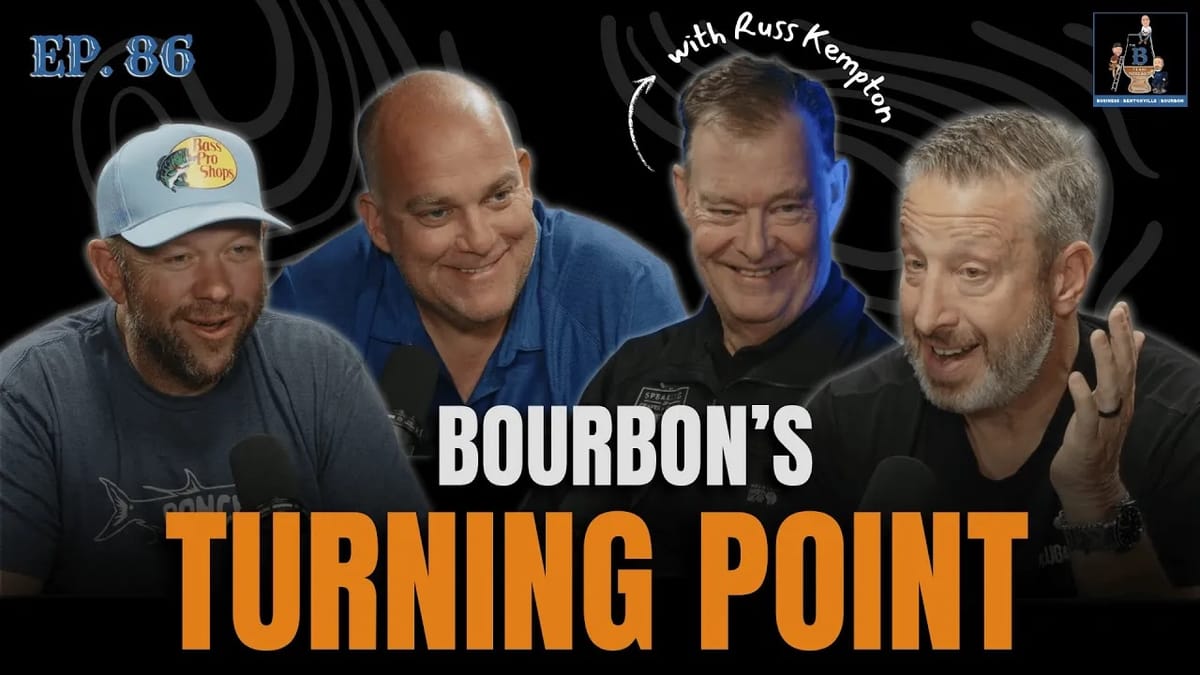Borrowed coffee cups, a sherry-finished pour, and a market plot twist: we crack open Horse Neck’s Kentucky Bourbon and unpack why the bourbon world suddenly feels upside down. We’re joined by our resident spirits pro to translate tasting notes into plain English, orange marmalade, licorice, toasted oak, and that cherry-friendly finish, and to explain why this bottle works neat, with a splash, or in an old-fashioned.
From there, we zoom out. Shelves that were bare a year ago now show Buffalo Trace by the case. E.H. Taylor and other favorites are popping up at or near MSRP. Meanwhile, several distilleries have paused production because inventory on hand can meet demand in the near term. That’s the X-point: a glut from years of aggressive barreling meeting consumer downtrading in a wobbly economy. We talk through what that means for pricing, secondary markets, and why some bottles may sit longer in oak, potentially turning good whiskey into great whiskey over the next few years.
If you’re tired of the bourbon chase, you’re not alone. Reposado, Añejo, and extra Añejo tequilas, especially additive-free standouts, are winning over bourbon palates with ex-bourbon barrel character and clearer value. Rum is a dark horse too, with well-aged, ex-American oak releases offering caramel, spice, and depth without the bourbon premium. We share practical strategies: build relationships with independents, test “walk by” labels you’ve ignored for years, and follow a simple rule of thumb, hold treasured allocations, buy quality value now, and skip panic selling.
If you enjoyed this, subscribe, leave a review, and share it with a friend who still thinks everything good is only behind the counter. What bottle are you hunting, or rediscovering, this week?
More About this Episode
Bourbon, Business, and the Changing Tides of American Whiskey: What the Downturn Really Means
The American bourbon industry is standing at a crossroads. For more than a decade, it was an unstoppable force, new distilleries opening left and right, prices soaring, and consumers chasing rare bottles like they were lottery tickets. But if you're paying attention lately, something's changed. We're seeing shelves stocked with previously “unicorn” bourbons, distilleries pausing production, and a noticeable consumer pivot.
In our recent conversation on the B Team Podcast, we dug deep into what’s happening right now with the bourbon market, the economics behind the shift, how tequila is stepping in as bourbon fatigue sets in, and what this all means for collectors, casual drinkers, and the industry at large.
Let’s unpack what’s really going on behind the scenes.
Bourbon’s Boom Years Are Slowing Down
The bourbon boom that began in the early 2010s was no accident. It came on the heels of well-strategized marketing campaigns, growing international demand, and a rising tide of connoisseurship among American drinkers. Small-batch, single barrel, bottled-in-bond, these terms became part of the everyday drinker's vocabulary. Suddenly, bourbon wasn’t just a Southern staple. It was everywhere.
But over the last six to twelve months, that fever has cooled. We’re seeing allocated bourbons like E.H. Taylor, Blanton’s, and even George T. Stagg popping up on shelves, not once a year, but regularly. That alone is a seismic shift. As we discussed on the show, even legacy retailers are dropping prices and opening access. Just two years ago, a bottle of Stagg Sr. might have cost you upwards of $1,600. Today? You can find one for around $850.
This isn’t just anecdotal. The bourbon industry is seeing a real contraction. Production is slowing down. Distilleries like George Dickel and Balcones have paused operations. We’re not talking small players, these are major brands owned by industry giants like Diageo. The reason? Oversupply, underconsumption, and economic uncertainty.
What’s Fueling the Shift? It’s Not Just the Economy
While rising inflation and economic unease certainly play a role, this bourbon slowdown isn't just about money. It's about fatigue.
Consumers, especially those who have chased rare bottles for years, are burned out. We’ve heard it repeatedly: “I’m tired of the hunt.” The joy of walking into a store and finding a great bottle at a fair price has been replaced by disappointment, flipping, and gatekeeping. For many, the magic is gone.
This exhaustion is reflected in the numbers. As we discussed in the episode, there are now over 1.5 billion gallons of whiskey aging in American warehouses, triple what was being aged just 15 years ago. That’s a glut by any standard. Combine that with a consumer base that’s drinking less (or switching categories), and you’ve got a recipe for disruption.
The Rise of Tequila and the New Age of Spirits
So where are drinkers going?
Straight to tequila.
Specifically, reposado and añejo tequilas, which offer a familiar oak-aged complexity that appeals to bourbon drinkers. Unlike unaged blancos, these tequilas rest in barrels, often ex-bourbon barrels, developing rich, layered profiles that mimic some of the characteristics of a good whiskey.
We’ve said this before, and now it's clearer than ever: Tequila is the new bourbon.
We’re seeing it in how often people ask for brands like Fortaleza, which, by the way, is becoming just as elusive as Pappy Van Winkle was five years ago. In fact, during a recent visit to a liquor store, I was told that the entire state only received two and a half cases of Fortaleza across all variants. That kind of allocation used to be reserved for the rarest bourbons.
And it’s not just Fortaleza. The market is buzzing with interest in additive-free tequilas and extra añejos that deliver depth and character without the synthetic sweetness that mass-market bottles sometimes carry.
Even major spirits companies are taking notice. Tito’s Vodka recently acquired LALO, a premium tequila brand founded by Don Julio’s grandson. That’s a serious bet on tequila’s long-term future.
From Bourbon to Rum? The Dark Horse of the Spirits World
Beyond tequila, there's a quieter movement brewing in the background: rum.
High-end aged rum, particularly from producers who use ex-bourbon barrels, is starting to attract attention. It’s still a niche market, but we’re already seeing comparisons to well-aged bourbons, and at a fraction of the cost.
You can find a 25-year-old rum for under $100. But there’s a catch. Not all age statements are created equal. Some bottles list “30 years” but are only aged up to 30 years, meaning most of the liquid inside could be much younger. As always, it’s buyer beware, especially in countries where spirits labeling isn't as tightly regulated as in the U.S.
The Value Shopper’s Time to Shine
For bourbon fans, this downturn presents a real opportunity, especially for those who appreciate value and have a knack for discovering hidden gems.
We tasted a bottled-in-bond bourbon from Sam’s Club recently, made by Sazerac, the same parent company behind Buffalo Trace and 1792. The verdict? It was shockingly good for a $20 bottle. Tasted blind, you'd probably guess it was something much more expensive.
Same goes for overlooked legacy brands like Wild Turkey 101 and Early Times Bottled in Bond. These have been around forever, and right now, they’re overdelivering at their price point.
Now is the time to go back to those “walk-by bourbons”, the ones you've seen a hundred times and dismissed. In a blind taste test, you might just discover they deserve a spot on your shelf.
So What Should You Do Right Now?
If you’re a collector: Hold.
The secondary market is soft. Prices are down, and selling now likely means taking a loss. Wait out the dip, and your patience will be rewarded.
If you're a drinker: Buy.
There’s more great bourbon available now than at any time in the last decade. You can find excellent bottles without overpaying or jumping through hoops. And if you're curious, start exploring aged tequilas and rums, you'll find complexity without the price tag.
If you’re a retailer or brand: Adapt.
The landscape is shifting. Gen Z isn't drinking like previous generations. Consumers are more health-conscious. RTDs (ready-to-drink) and non-alcoholic alternatives are gaining ground. And the “cool factor” that bourbon enjoyed for the last 15 years is moving elsewhere. Survival now depends on diversification, transparency, and building authentic relationships with customers.
Final Thoughts
This bourbon downturn isn’t the end of the world. It’s a correction, and frankly, one that’s overdue. The market was oversaturated, expectations were inflated, and access became a grind.
What we’re seeing now is a realignment. One that puts the focus back on drinking rather than chasing. One that rewards curiosity and punishes hype. And for those of us who truly love spirits, not just collecting them, that’s a win.
So go visit your local package store. Talk to the owner. Look behind the counter. Revisit those brands you’ve been walking past for years.
There’s good bourbon out there. And for the first time in a long time, it’s back on the shelf, and maybe even on sale.


Member discussion: